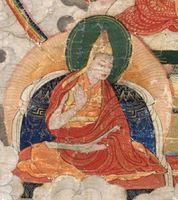Gyaltsap Je Darma Rinchen
Rgyal tshab rje dar ma rin chen
| PersonType | Category:Classical Tibetan Authors |
|---|---|
| MainNamePhon | Gyaltsap Je Darma Rinchen |
| MainNameTib | རྒྱལ་ཚབ་རྗེ་དར་མ་རིན་ཆེན་ |
| MainNameWylie | rgyal tshab rje dar ma rin chen |
| AltNamesTib | རྒྱལ་ཚབ་རྗེ་ · དགའ་ལྡན་ཁྲི་པ་༠༢་ |
| AltNamesWylie | rgyal tshab rje · dga' ldan khri pa 02 |
| AltNamesOther | Ganden Tripa, 2nd |
| BiographicalInfo | Alternative birth date 1362.
|
| YearBirth | 1364 |
| YearDeath | 1432 |
| BornIn | myang stod ri nang (gtsang) |
| TibDateGender | Male |
| TibDateElement | Wood |
| TibDateAnimal | Dragon |
| TibDateRabjung | 6 |
| ReligiousAffiliation | dge lugs |
| StudentOf | Tsongkhapa · Rendawa Zhönu Lodrö |
| TeacherOf | Jamyang Chöje Tashi Palden · Gendün Drup · mkhas grub rje · 'dul 'dzin grags pa rgyal mtshan |
| BDRC | https://www.tbrc.org/#!rid=P65 |
| Treasury of Lives | https://treasuryoflives.org/biographies/view/Gyeltsab-Darma-Rinchen/9095 |
| IsInGyatsa | No |
| PosBuNayDefProv | Definitive |
| PosBuNayDefProvNotes | "So, Gyeltsap claims that both the Madhyamakāvatāra and the Uttaratantra explain the same meaning of ultimate truth. Hence, they are both definitive works that explicate the intention of the middle wheel." Wangchuk, Tsering, The Uttaratantra in the Land of Snows, p. 107. |
| PosAllBuddha | Qualified Yes |
| PosAllBuddhaNote | "Gyeltsap thus shows that ultimately both buddhas and sentient beings share the same suchness of mind which is the ultimate nature of mind that is free from natural defilements. Because of this he argues that all sentient beings have tathāgata-essence, and it is through this that he establishes the connection between tathāgata-essence and the concept of one-vehicle, the notion that ultimately there is only the final goal of buddhahood." |
| PosAllBuddhaMoreNotes | Wangchuk, Tsering, The Uttaratantra in the Land of Snows, p. 99. |
| PosWheelTurn | Second Turning |
| PosWheelTurnNotes | "So, Gyeltsap claims that both the Madhyamakāvatāra and the Uttaratantra explain the same meaning of ultimate truth. Hence, they are both definitive works that explicate the intention of the middle wheel." Wangchuk, Tsering, The Uttaratantra in the Land of Snows, p. 107.
|
| PosYogaMadhya | Madhyamaka |
| PosYogaMadhyaNotes |
|
| PosZhenRang | Rangtong |
| PosVehicles | 1 |
| PosVehiclesNotes | "Gyeltsap thus shows that ultimately both buddhas and sentient beings share the same suchness of mind which is the ultimate nature of mind that is free from natural defilements. Because of this he argues that all sentient beings have tathāgata-essence, and it is through this that he establishes the connection between tathāgata-essence and the concept of one-vehicle, the notion that ultimately there is only the final goal of buddhahood." Wangchuk, Tsering, The Uttaratantra in the Land of Snows, p. 99. |
| PosEmptyLumin | Tathagatagarbha as the Emptiness That is a Nonimplicative Negation |
| PosEmptyLuminNotes | "In brief, Gyeltsap argues that buddha-nature, or tathāgata-essence, does not refer to a fully enlightened entity covered by adventitious defilements. Rather it is the same as the emptiness of inherent existence that is explicated in texts such as the Prajñāpāramitāsūtras and Madhyamakāvatāra." Wangchuk, Tsering, The Uttaratantra in the Land of Snows, p. 106. |
| PosSvataPrasa | Prāsaṅgika (ཐལ་འགྱུར་) |
| PosSvataPrasaNotes | "In his Uttaratantra commentary, Gyeltsap shows the strong influence of Tsongkhapa's Illuminating the Thoughts of the Madhyamaka. He criticizes those who propose that the Uttaratantra is a Cittamātra text, arguing that it explicates the ultimate truth presented in the Prāsaṅgika-Madhyamaka." Wangchuk, Tsering, The Uttaratantra in the Land of Snows, p. 98. |
| Other wikis |
If the page does not yet exist on the remote wiki, you can paste the tag |
"Tathagatagarbha as the Emptiness That is a Nonimplicative Negation" is not in the list (Tathāgatagarbha as the Emptiness That is a Non-implicative Negation (without enlightened qualities), Tathāgatagarbha as the Emptiness That is an Implicative Negation (with enlightened qualities), Tathāgatagarbha as Mind's Luminous Nature, Tathāgatagarbha as the Unity of Emptiness and Luminosity, Tathāgatagarbha as a Causal Potential or Disposition (gotra), Tathāgatagarbha as the Resultant State of Buddhahood, Tathāgatagarbha as the Latent State of Buddhahood that is Obscured in Sentient Beings, There are several types of Tathāgatagarbha, Tathāgatagarbha was Taught Merely to Encourage Sentient Beings to Enter the Path) of allowed values for the "PosEmptyLumin" property.

